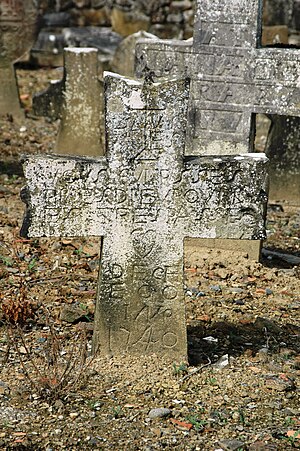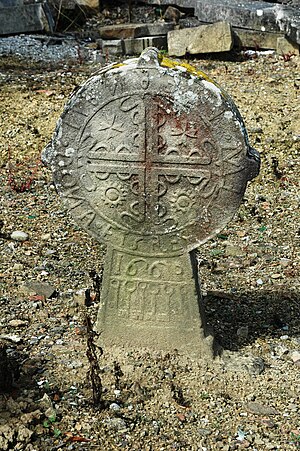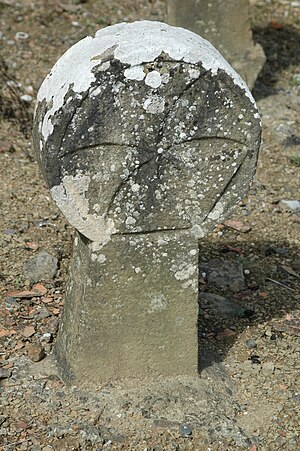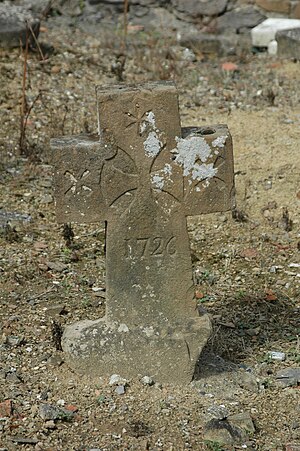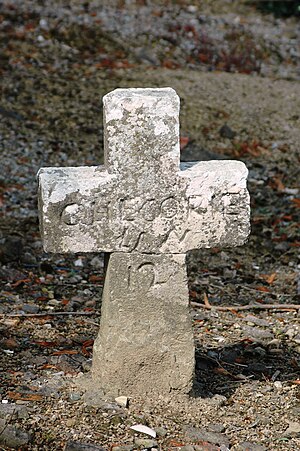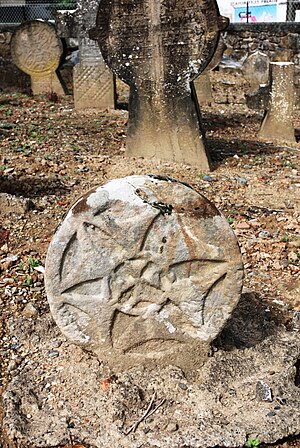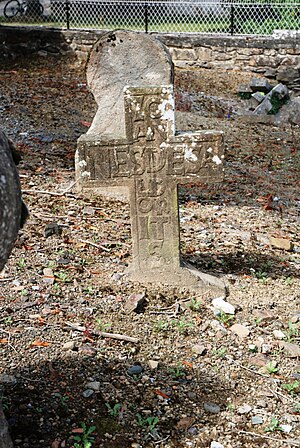Masparraute
|
Masparraute Martxueta |
||
|---|---|---|
|
|
||
| region | Nouvelle-Aquitaine | |
| Department | Pyrénées-Atlantiques | |
| Arrondissement | Bayonne | |
| Canton | Pays de Bidache, Amikuze et Ostibarre | |
| Community association | Pays Basque | |
| Coordinates | 43 ° 23 ′ N , 1 ° 6 ′ W | |
| height | 26–123 m | |
| surface | 8.16 km 2 | |
| Residents | 234 (January 1, 2017) | |
| Population density | 29 inhabitants / km 2 | |
| Post Code | 64120 | |
| INSEE code | 64368 | |
 Masparraute Town Hall |
||
Masparraute is a French municipality with 234 inhabitants (at January 1, 2017) in the department of Pyrénées-Atlantiques in the region Nouvelle-Aquitaine (before 2016: Aquitaine ). The municipality belongs to the Bayonne arrondissement and the canton of Pays de Bidache, Amikuze et Ostibarre (until 2015: canton of Saint-Palais ).
The name of the municipality is Martxueta in the Basque language . The inhabitants are called Martxuetar accordingly .
geography
Masparraute is located approx. 45 km southeast of Bayonne in the historical Pays de Mixe ( Basque Amikuze ) of the historical region of Lower Navarra in the French part of the Basque Country .
Masparraute is surrounded by the neighboring communities:
| Arraute-Charritte | Bergouey-Vlichenave | |

|
Labets-Biscay | |
| Cupid's succos | Béguios |
Masparraute lies in the catchment area of the Adour River . The Minhurièta Erreka, a tributary of the Bidouze , together with its tributary, the Faitureko Erreka, crosses the area of the municipality as does the Apatharena, a tributary of the Lihoury .
history
The Masparraute family gave the community its name. She owned a castle in the 11th century with a watermill that operated for a long time. In the 13th century the village experienced a high point when its landlord had the honor of taking part in the homage of Sancho VII , King of Navarre , in the castle of Gramont , accompanied by other landlords of Lower Navarre .
Toponyms and mentions of Masparraute were:
- Mansbar diamond (1080 and 1119),
- Mauzbarraute (1080, manuscript collection by André Duchesne , volume 114, sheet 32),
- Mazber diamond (1119),
- Sanctus Stephanus de Manzberraute (1160),
- Mans-Barraute and Mazbarraute (12th century, copy book of the Abbey of Saint-Jean de Sorde , p. 24 and p. 29),
- Mazperaute (1309),
- Mazparraute (1402, deeds of the Kingdom of Navarre),
- Mazparraute and Marchoete (1413),
- Masperaute , Masberrauta , Masparrauta and Masperrauta (1434, 1443, or 1462 for the last two forms, notaries of Oloron , No. 3, sheet 26 and No. 4, sheet 9, 10 and 76),
- Mazparrauta (1513, documents from Pamplona ) and
- Masparraute (1750, map by Cassini ).
Population development
After a peak in the number of inhabitants of around 680 at the beginning of the 19th century, the number fell to around 210 inhabitants by the turn of the millennium during short recovery phases, especially in the 1930s, before moderate growth began.
| year | 1962 | 1968 | 1975 | 1982 | 1990 | 1999 | 2006 | 2009 | 2017 |
|---|---|---|---|---|---|---|---|---|---|
| Residents | 346 | 292 | 268 | 265 | 230 | 211 | 240 | 249 | 234 |
Attractions
- Parish church dedicated to St. Stephen . It was probably built in the 18th century, as the corresponding year above the western main entrance shows, and restored in 1836. The main facade is divided into three sections. The first part consists of the main entrance with a triangular gable and two arched windows. Above it is a narrower trapezoidal part with curved sides. The upper part consists of the bell tower with a clock tower below the sound opening of the bell chamber. It has a slate- covered pyramid roof , surrounded by four ridge turrets . The single nave nave is closed off by a flat apse . Inside, wooden galleries on two levels run around the nave on three sides. In addition to a remarkable stoup around an ornate column , the church has a baroque altarpiece similar to that of the parish church of Orègue . Framed by six serpent columns, there are several statues in niches and a painting in the center of the work of art, which, like the church, is dedicated to St. Stephen. It represents the moment of his martyrdom through a stoning . According to his speech before the Sanhedrin , “I see heaven open and the Son of man standing at the right hand of God”, heaven opens in the picture and shows Jesus Christ . A memorial to the memory of those who died in the wars is to the right of the main entrance, which was largely made of the reddish sandstone of the Pays de Mixe . The names of those who died in the wars of the 20th century in the municipality are entered in the lower part, which has the shape of a "V". The upper part is a stele on which a cross and laurel branches, symbols of victory, are applied. The memorial thus unites the symbols of the fatherland and Christianity in one location between the church and the cemetery.
- Masparraute cemetery. Disc-shaped grave stelae, called Hilarri , and old grave crosses can be seen in the cemetery in the immediate vicinity of the parish church. The disc-shaped grave stelae appeared in the 15th century, inspired by paganism in the early history of the Basque Country. Nevertheless, they are signs of practiced Christianity, expressed through harmonious motifs on the discs, which often appear in the form of Christian crosses. The grave crosses in the classical form come from a later period. They are also often decorated with sculptural ornamentation and are reminiscent of the lapidary style in funeral arts in the Basque Country. A disc-shaped grave stele in the cemetery dates from 1660. The composition of the engravings shows a mixture of symbols of the earlier pagan cult and Christian monotheism . The center of the disc is occupied by a Greek cross . There are two small Maltese crosses above the side arms. On the other hand, two suns below the arms suggest the meaning of stars in pagan belief. On the base of the stele a number of keys can be seen, which symbolize entry into paradise according to Christian belief. The stripe that surrounds the disk shows inscriptions in Latin script, which presumably name the deceased and his house. Given the complexity of the decorations, this grave stele probably belonged to a wealthy family. The cemetery cross stands out due to its mix of materials and the precision of its forms. The proportions of the work almost correspond to the real sizes. A white stone statue of Christ is nailed to a wooden cross. A banner, also made of white stone, is attached above the statue and bears the inscription " INRI ". The cross is in all likelihood the work of a local artist from the late 19th century.
- House of the sexton . A peculiarity of the Basque Country in earlier centuries is the office of sexton, which is probably due to the matriarchal tradition of Basque society. It was dressed by a young woman or widow and was responsible for keeping the keys of the church, maintaining the church and distributing the blessed bread. A sexton's house is usually located near the parish church, as is the case in Masparraute. The disappearance of this office is partly due to the persecution of heretics in the 17th century. Pierre de Lancre was commissioned by the French King Henry IV to take care of witchcraft in the Basque Country, and sextons in this context were perceived as a disclosure of Satanism .
Economy and Infrastructure
Agriculture has traditionally been an important economic factor in the municipality. Masparraute is located in the AOC zones of Ossau-Iraty , a traditionally produced semi-hard cheese made from sheep's milk, as well as the pig breed and the ham "Kintoa".

Total = 29
traffic
Masparraute is crossed by Routes départementales 11 and 246 and is connected to Bayonne and other communes in the department by a line from the Transports 64 bus network .
Web links
- Masparraute on the Montagne Basque Tourist Office website (French)
- "Transports 64" bus from the department (French)
- Website of the AOP Ossau-Iraty association (French)
- Information on the “Kintoa” ham on the Montagne Basque Tourist Office website (French)
Individual evidence
- ↑ Lieux - toponymie: Martxueta (Amikuze) ( fr ) Royal Academy of the Basque Language . Retrieved September 12, 2017.
- ↑ Ma commune: Masparraute ( fr ) Système d'Information sur l'Eau du Bassin Adour Garonne. Retrieved September 12, 2017.
- ↑ a b Masparraute ( fr ) Visites en Aquitaine. Archived from the original on September 12, 2017. Info: The archive link was inserted automatically and has not yet been checked. Please check the original and archive link according to the instructions and then remove this notice. Retrieved September 12, 2017.
- ^ Jean-Baptiste Orpustan: Nouvelle toponymie basque ( fr ) University of Bordeaux . S. 80. 2006. Retrieved September 12, 2017.
- ^ Paul Raymond: Dictionnaire topographique du département des Basses-Pyrénées ( fr ) In: Dictionnaire topographique de la France . Imprimerie nationale. P. 109, 1863. Retrieved September 12, 2017.
- ^ David Rumsey Historical Map Collection France 1750 ( en ) David Rumsey Map Collection: Cartography Associates. Retrieved September 12, 2017.
- ↑ Notice Communale Masparraute ( fr ) EHESS . Retrieved September 12, 2017.
- ↑ Populations légales 2014 Commune de Masparraute (64368) ( fr ) INSEE . Retrieved September 12, 2017.
- ↑ Conseil régional d'Aquitaine: Église Saint-Étienne ( fr ) Visites en Aquitaine. Archived from the original on September 12, 2017. Info: The archive link was inserted automatically and has not yet been checked. Please check the original and archive link according to the instructions and then remove this notice. Retrieved September 12, 2017.
- ↑ église paroissiale Saint-Etienne ( fr ) Ministry of Culture and Communication . Retrieved September 12, 2017.
- ^ Conseil régional d'Aquitaine: Monument aux morts de Masparraute ( fr ) Visites en Aquitaine. Archived from the original on September 12, 2017. Info: The archive link was inserted automatically and has not yet been checked. Please check the original and archive link according to the instructions and then remove this notice. Retrieved September 12, 2017.
- ^ Conseil régional d'Aquitaine: Cimetière à stèles discoïdales de Masparraute ( fr ) Visites en Aquitaine. Archived from the original on September 12, 2017. Info: The archive link was inserted automatically and has not yet been checked. Please check the original and archive link according to the instructions and then remove this notice. Retrieved September 12, 2017.
- ↑ Conseil régional d'Aquitaine: Stèle discoïdale du cimetière de Masparraute ( fr ) Visites en Aquitaine. Archived from the original on September 12, 2017. Info: The archive link was inserted automatically and has not yet been checked. Please check the original and archive link according to the instructions and then remove this notice. Retrieved September 12, 2017.
- ↑ Regional Council of Aquitaine: Croix du cimetière de Masparraute ( fr ) Visites en Aquitaine. Archived from the original on September 12, 2017. Info: The archive link was inserted automatically and has not yet been checked. Please check the original and archive link according to the instructions and then remove this notice. Retrieved September 12, 2017.
- ↑ Regional Council of Aquitaine: Benoîterie de Masparraute ( fr ) Visites en Aquitaine. Archived from the original on September 12, 2017. Info: The archive link was inserted automatically and has not yet been checked. Please check the original and archive link according to the instructions and then remove this notice. Retrieved September 12, 2017.
- ↑ Institut national de l'origine et de la qualité: Rechercher-un-produit ( fr ) Institut national de l'origine et de la qualité . Retrieved September 12, 2017.
- ↑ Caractéristiques des établissements en 2015 Commune de Masparraute (64368) ( fr ) INSEE . Retrieved September 12, 2017.






